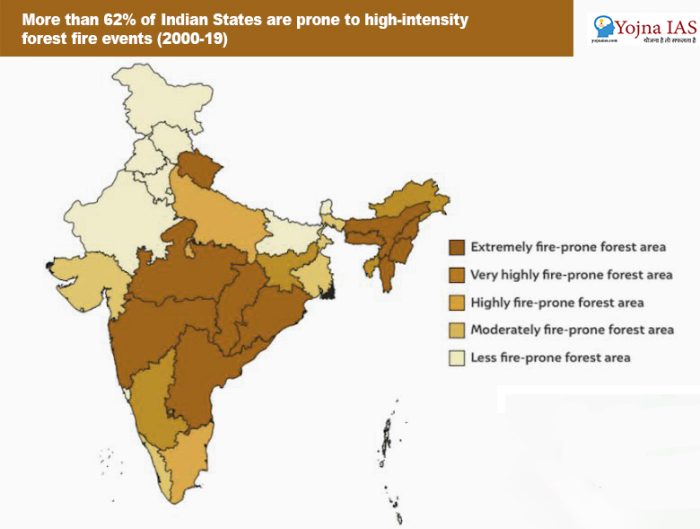21 Mar 2024 Forest fire in Nilgiris
This article covers ‘Daily Current Affairs’ and the topic details of ”Forest fire in Nilgiris”. This topic is relevant in the “Environment” section of the UPSC CSE exam.
Why in the News?
Lately, there have been extensive forest fires occurring in the Coonoor forest range located in the Nilgiris region of Tamil Nadu. To aid in combating these fires, the Indian Air Force has become involved in the ongoing firefighting endeavours led by the state forest department. They have deployed a Mi-17 V5 helicopter to carry out numerous operations using “Bambi Buckets.”
About Forest Fires
- Forest fires, also known as wildfires, bushfires, or vegetation fires, are a terrifying force of nature. They are uncontrolled and unplanned blazes that erupt in natural areas like forests, grasslands, brushlands, or even tundras. Fueled by dry vegetation and driven by environmental conditions like wind and topography, these fires consume everything in their path, leaving a trail of destruction.
- For any fire to burn, three key ingredients are essential: fuel, oxygen, and heat. In a forest, the fuel comes from dead leaves, twigs, dry grasses, and other organic matter on the forest floor and within the trees themselves.
- Oxygen is readily available in the atmosphere, and the heat source can be triggered by lightning strikes, human activities, or even natural friction from rubbing branches during strong winds.
Different Types of Forest Fires
Forest fires can be categorised into the following types based on where they burn:
- Surface Fires: These are the most common type, burning the forest floor litter like leaves, twigs, and dry grasses. They are generally easier to contain compared to other fire types.
- Underground Fires: These stealthy fires creep beneath the surface, consuming organic matter like peat and roots. Often found in dense forests with thick layers of organic matter, they can be challenging to detect and extinguish, sometimes smouldering for months.
- Canopy or Crown Fires: The most ferocious of the bunch, crown fires rage through the upper tree canopy, fueled by dry leaves and branches. Driven by strong winds, they are incredibly intense and difficult to control, posing a significant threat to both life and property.
- Controlled Burns: Not all fires are destructive. Prescribed burns, or controlled deliberate fires, are strategically set by forest managers. These controlled fires help reduce built-up fuel loads, minimising the risk of future wildfires and promoting overall ecosystem health. Careful planning and execution are crucial for prescribed burns to achieve their intended benefits.
Forest fires in India
- Forest fires in India present a significant environmental challenge, with various statistics and facts shedding light on their impact. According to the Forest Survey of India, there have been approximately 277,758 forest fire points detected across the country from 2004/5 to 2017, highlighting the widespread nature of this issue.
- Mizoram stands out as one of the areas with a high incidence of forest fires in India.
- The forest fire season in India typically coincides with the onset of summer, characterised by rising temperatures and dry conditions that create a conducive environment for wildfires. For instance, between 13 and 20 February 2023, nearly 1,156 forest fires were reported in India, marking an early start to the forest fire season and indicating a spike in daytime temperatures.
- Human activity has been identified as a primary cause of forest fires in India, with climate change exacerbating the situation.
- Studies have shown a link between climate change and the increased frequency and severity of fire weather, with rising global temperatures, heatwaves, and droughts contributing to the likelihood of wildfires by creating hot and dry conditions favourable for fire outbreaks.

Reasons behind the forest fires
Natural Factors
- Lightning Strikes: One of Nature’s Ignition Sources: Lightning strikes, especially during dry seasons, can trigger forest fires by igniting dry vegetation.
- Extreme Weather Conditions: Fueling the Flames: Hot and dry weather conditions create a conducive environment for the rapid spread of forest fires, amplifying their frequency and intensity.
Human Activities
- Agricultural Practices: The Double-Edged Sword: Clearing land for agriculture through slash-and-burn techniques or improper disposal of crop residues can inadvertently spark forest fires.
- Uncontrolled Burning: The Unseen Consequences: Deliberate burning of vegetation for various purposes, such as land clearing, hunting, or waste disposal, often leads to uncontrolled wildfires.
- Industrial Activities: Igniting Environmental Hazards: Industrial activities like mining, logging, and construction can inadvertently cause forest fires through machinery sparks or negligence.
Social and Cultural Factors
- Discarded Waste: A Smouldering Issue: Improper disposal of cigarette butts, glass bottles, or other flammable materials in forested areas poses a significant fire risk.
- Human Settlements: Living on the Edge: Encroachment of human settlements into forested areas increases the likelihood of accidental fires due to cooking, smoking, or other human activities.
Download Yojna daily current affairs eng med 21st March 2024
Prelims practise questions
Q1. Consider the following statements regarding National Disaster Management Authority:
- The President is the head of the National Disaster Management Authority in India.
- National Disaster Management Authority (NDMA) was established in 2005
- Disaster Management Act, 1999 provides the legal framework for the functioning of the National Disaster Management Authority in India
How many of the above statements are correct?
(a) Only one
(b) Only two
(c) All three
(d) None
ANSWER: A
Mains practise questions
Q1. Discuss the socio-economic impacts of forest fires on local communities in India. How do these events affect livelihoods, biodiversity, and ecosystem services, and what strategies can be employed to address these challenges?
I am a content developer and have done my Post Graduation in Political Science. I have given 2 UPSC mains, 1 IB ACIO interview and have cleared UGC NET JRF too.


No Comments